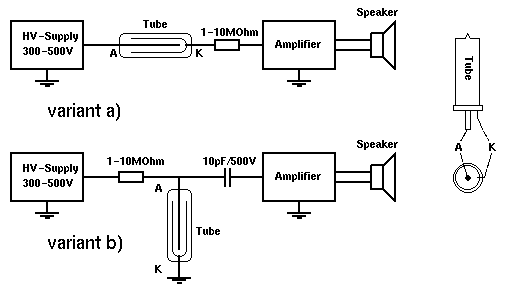Geiger counters
Geiger counters are devices to detect and measure ionizing radiation, as emitted by radioactive sources. The heart of a geiger counter is the Geiger-Mueller-Tube. This is a gas filled tube, to which a voltage of several 100V is applied. Normally, the gas insulates and no current is drawn. When a radiation particle or quantum passes the tube, it triggers a gas discharge, i.e. gas becomes conducting. The resulting current impulse can be amplified and made visible or hearable ("clicking").
This was a very basic explanation. For a more detailed and advanced treatment, see this article which was copied from Caltech.
There are two main kinds of tubes:
- Glas mantle tubes are only suitable for beta and gamma rays, as any alphas are absorbed in the glass. They can be used for quantitatively measuring gamma dose-rate. Glas mantle tubes are comparatively cheap, they can be bought from electronic shops from about 100DM.
- Window tubes have a window (usually at one end), which is sealed with a very thin foil or mica. Alphas can penetrate this window, and thus be detected, as well as betas and gammas. As the window is very thin, it is extremely prone to puncture. Window tubes are more expensive and less common, they can be bought from about 150DM.
A typical Geiger counter circuit looks like this:

Variant b) has the advantage of proper grounding, so that the tube is electrically shielded by its cylindrical cathode.
Geiger counters can be bought complete or as kits from many electronic and surplus stores, but can also be self-designed. The following plans will give you some clues.
[Back to Index]
[Other links]
Jochen
Kronjaeger
Kronjaeg@stud-mailer.uni-marburg.de

